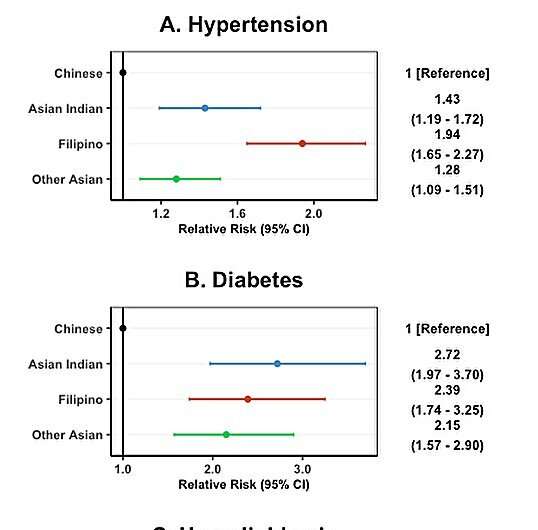This article has been reviewed according to Science X's editorial process and policies. Editors have highlighted the following attributes while ensuring the content's credibility:
fact-checked
trusted source
proofread
Asian groups in US differ when it comes to cardiovascular disease and its risks

Cardiovascular disease varies greatly across Asian American ethnic groups, underscoring the need to study each individually when it comes to prevention and treatment, according to new research.
Asian people are the fastest-growing racial group in the country. At about 24 million people, they make up 7% of the U.S. population—nearly 40% of them of Chinese descent, according to census data. They are a highly diverse population, yet there's little research on how cardiovascular disease and its risk factors vary among them.
For the new study, researchers looked at data from the National Health Interview Survey from 2013 to 2018, representing about 13 million Asian adults. They were divided into four groups: Chinese, Asian Indian and Filipino people, the nation's three largest Asian ethnic groups, and a fourth group of people with other Asian heritage.
After adjusting the data for age and sex, researchers found that Filipino, Asian Indian and other Asian adults were more likely than Chinese adults to have high blood pressure, diabetes, high cholesterol and obesity. Researchers also found Filipino adults were far more likely than Chinese adults to have a history of heart attack, stroke and coronary artery disease.
The findings were presented in November at the American Heart Association's Scientific Sessions 2023 conference in Philadelphia. They are considered preliminary until full results are published in a peer-reviewed journal.
Cardiovascular health among Asian Americans is "a complex one," said the study's lead researcher, Sudheesha Perera, a medical student at the Warren Alpert Medical School of Brown University in Providence, Rhode Island. "These results showed evident disparities within Asian American populations," particularly the higher burden and risk of disease among Filipino adults.
Health behaviors and social determinants of health, like education, health insurance and income, did not fully explain differences between the groups, he said. "But one thing we picked out in our study was that rates of smoking are higher among Filipino adults."
Perera said more research is needed into the cause of the disparities, adding that the Asian community is all too often considered a monolith in national public health initiatives.
The research was limited by self-reported data that still aggregated certain subgroups, Perera said. "We stuck to the major subgroups available in the database, but other Asian communities, such as Vietnamese, Korean and Japanese communities, also deserve a thorough, holistic analysis of cardiovascular disease." He also called for future research to explore how immigration is associated with the patterns of heart health across diverse groups of Asian Americans.
Dr. Latha Palaniappan, an internal medicine doctor and a professor of cardiovascular medicine at Stanford University in California, agreed with Perera that the findings point to a dire need for more research. She said there's a particular lack of studies on which Asian groups are most at risk for various types of stroke.
"In order to practice precision medicine, we need more data on the differences in this diverse and growing population—not only cardiovascular disease, but cancer, mental health, asthma, and the list goes on," said Palaniappan, who was not involved in the current research.
Asian people make up a very small fraction of clinical trial participants in the U.S. "Often, when Asians are included, they're grouped together, which hides important differences in disease prevalence and treatment across diverse subgroups," Palaniappan said.
She encouraged more Asian American people to participate in clinical trials, "so we can assure that drugs and devices are tested appropriately in all populations that we treat."
More information: Sudheesha Perera et al, Disaggregating the Burden of Cardiovascular Risk Factors and Disease Among Asian Subpopulations in the United States. www.abstractsonline.com/pp8/?_ … 71/presentation/9206



















